New Materials and Device Fabrication Methods
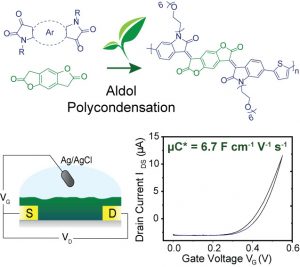
"Green” polymerization of n-type conjugated polymers for bioelectronics
Mixed ionic/electronic conductors are core components of modern bioelectronic devices. To innovate bioelectronic applications, one key focus is to introduce new materials or modify existing materials to provide or improve function. We are collaborating with Yue Lab on the integration of new building blocks, synthesis strategies, and post-synthesis processing methods to improve state-of-the-art bioelectronics.
Sustainability considerations are at the core of this research theme. We believe that future electronic materials will be synthesized using green synthesis routes and fabricated using cleanroom-free, energy-efficient processes. We are investigating new materials and fabrication routes for the next generation of sustainable electronics
Biodegradable Organic Electronics
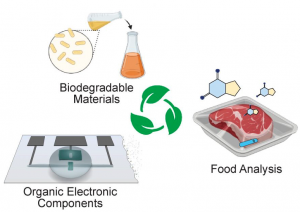
Biodegradable bioelectronics aim to produce technologies that monitor/modulate biological functions and safely integrate into life and the environment. It aims to eliminate the need for bioelectronic implant retrieval and to produce zero waste solutions for consumer electronics. Integration of degradable substrates with water-soluble electronic components (metals and semiconductors) led to the first examples of bioresorbable electronic implants. A key challenge for bioelectronics is to develop devices combining high performance, stable operation, and controlled degradation at the end of their life cycle.
We are working on materials and device design to provide the functionality needed for efficient device operation with biodegradation after service life. Our aim is to develop biodegradable organic electronic devices whose performance and degradation are tailored to specific applications, such as biodegradable implants or biosensors for smart packaging.
Conjugated Polymers for Assessing and Controlling Biological Functions
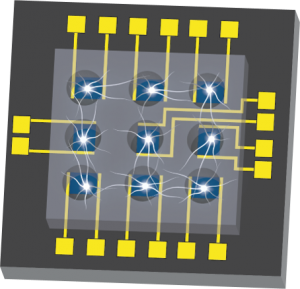
Sketch of an array of organic FETs on an organized neural network
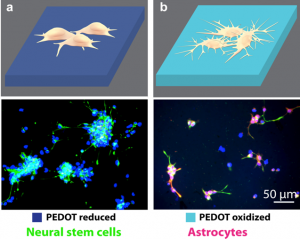
Using heparin-incorporating conjugated PEDOT we developed a switch that can turn on stem cell differentiation via presentation of FGF (fibroblast growth factor)
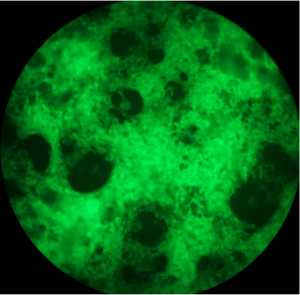
GFP-expressing IPS-differentiated cardiomyocytes
We develop materials and devices within the field of organic bioelectronics for the control, stimuli, and sensing of mammalian cells. Projects include controlling stem cell niches with redox-controlled growth factor presentation, the development of new devices and membrane intercalating conjugated polymers for improved electrophysiology interfaces for stem-cell-derived neurons and cardiomyocytes, and organic electronics-based metabolic sensors.
For more details, please contact Dr. Erica Zeglio
Collaborations:
Wan Yue, Sun Yat-sen University, China
Xiaojun Guo, Shanghai Jiao Tong University, China
Max Hamedi, Royal Institute of Technology, KTH
Anna F. Wistrand, Royal Institute of Technology, KTH
Tiziana Fuoco, Royal Institute of Technology, KTH
Key Publications:
- Y. Wang, E. Zeglio*, L. Wang, S. Cong, G. Zhu, H. Liao, J. Duan, Y. Zhou, Z. Li, D. Mawad, A. Herland, W. Yue,* I. McCulloch, Green Synthesis of Lactone‐Based Conjugated Polymers for n‐Type Organic Electrochemical Transistors, Advanced Functional Materials (2022). doi:10.1002/adfm.202111439.
- Y. Wang, E. Zeglio*, H. Liao, J. Xu, F. Liu, Z. Li, I. P. Maria, D. Mawad, A. Herland, I. McCulloch, W. Yue* Hybrid Alkyl-glycol Side Chains Enhance Substrate Adhesion and Operational Stability in Accumulation Mode Organic Electrochemical Transistors, Chemistry of Materials, 31, 9797 (2019).
- S. R. McCuskey, J. Chatsirisupachai, E. Zeglio, O. Parlak, P. Panoy, A. Herland*, G. C. Bazan*, T.-Q. Nguyen*, Current Progress of Interfacing Organic Semiconducting Materials with Bacteria, Chemical Reviews, 122 (4),4791 (2021).
- E. Zeglio, A. Rutz, T. Winkler, G. Malliaras,* A. Herland,* Conjugated Polymers for Assessing and Controlling Biological Functions, Advanced Materials, 31, 1806712 (2019).
- E. Zeglio*, O. Inganäs,* Active Materials for Organic Electrochemical Transistors, Advanced Materials, 30, 1800941 (2018).
- A. Herland, K. M. Persson, V. Lundin, M. Fahlman, M. Berggren, E. W. H. Jager, A. I. Teixeira, Electrochemical Control of Growth Factor Presentation To Steer Neural Stem Cell Differentiation, Angewandte Chemie Int. Ed., 50 (52), 12529, (2011).
- V. Lundin, A. Herland, M. Berggren, E. W. H. Jager, A. I. Teixeira, Control of Neural Stem Cell Survival by Electroactive Polymer Substrates, Plos One, 6 (4), e18624, (2011).
This project has received funding from the European Union’s Horizon 2020 research and innovation programme under the Marie Sklodowska-Curie grant
agreement No 101025599.
